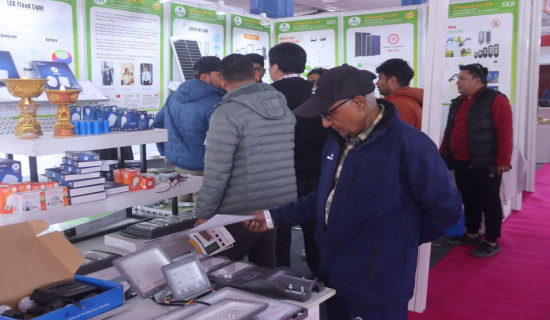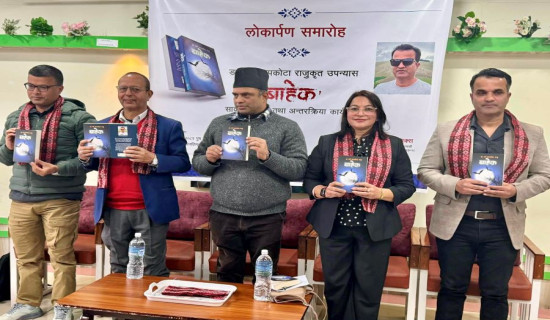- Saturday, 20 December 2025
Kathmandu's Traffic Crisis Needs BRT
A city's public transportation system is a key indicator of its vitality, organisational efficiency, and commitment to inclusivity. Effective systems prioritise robust infrastructure, meticulous planning, universal accessibility, reliable service, passenger comfort, and seamless journeys. Ideally, in a mixed-use city like Kathmandu, one could step out of their home, walk a few minutes to catch an electric tempo, and connect to a mass transit system such as a Bus Rapid Transit (BRT) station. This ensures people can move smoothly even during peak traffic, relying on schedules or apps for accurate travel times.
Despite high import duties and maintenance costs, Kathmandu's roads are flooded with motorcycles and an increasing number of private cars. This rise in private vehicle ownership is a sign of growing affluence and a reflection of a broken public transit system. Two-wheelers have become the go-to choice for daily commutes because buses are unreliable and inconvenient.
The result? Overwhelmed roads, traffic bottlenecks, and hours lost to congestion. A recent example: it took nearly an hour to travel just 4 kilometres, an absurd delay for such a short distance. In contrast, a well-functioning bus should cover that stretch in under 20 minutes, even accounting for stops and signals.
While walking remains a practical option for short distances, it's made unpleasant by broken sidewalks, air pollution, and dangerous road crossings. Pedestrian signals are insufficient, and drivers often ignore crossing rules. Unlike Sydney, where vehicles stop for pedestrians, Kathmandu's roads require collective assertiveness from pedestrians to cross safely. This lack of discipline and regulation translates into grim statistics: in just the first six months of 2024, 88 people died and nearly 4,600 were injured in road accidents within Kathmandu.
Traffic police try hard but rely on outdated manual systems, with no dedicated traffic engineers or proper infrastructure to support their work. The result is chaos and the need for a fundamental shift toward mass public transit.
Numerous studies have assessed Kathmandu's transport needs. In 2017, JICA proposed an Automated Guideway Transit (AGT) system for high-demand routes in the north-south route and west-east axis, with BRT acting as a feeder. It also recommended constructing an inner and outer ring road and building a flyover at Tripureshwor-Maitighar.
The Asian Development Bank (ADB) in 2018 suggested a steel rail system and the establishment of a regional transport authority. In 2019, another JICA study proposed intersection improvements, better traffic management, and an electric urban railway between Kathmandu and Bhaktapur.
Transport initiatives
Some progress has been made. The Kathmandu Sustainable Urban Transport Project (KSUTP) launched a pilot project replacing small, inefficient minibuses with 17 larger diesel buses along a key corridor. The 61 previous owners were consolidated into a single company, Digo Sarbajanik Yatayat, with financial support from the Town Development Fund and an ADB grant. This included GPS systems, electronic ticketing, and a government-regulated service-level agreement outlining routes, fares, and schedules.
Sajha Yatayat, a semi-public operator, has pioneered electric mobility. Between 2022 and 2024, it added 40 electric buses and installed 24 charging stations across the Valley. Meanwhile, the Federal Capital City Public Transport Authority (FCCPTA), established in 2022, was intended to lead public transport planning but has faced challenges due to poor coordination among local and federal agencies.
On the infrastructure side, projects like the Kalanki underpass, the Gwarko flyover, and the expansion of Ring Road have somewhat eased congestion along the Ring Road segment. A rapid bus service was launched in 2023 on the 13.4 km Ratnapark–Suryabinayak route to cut peak hour travel times from 2 hrs to 45 minutes. Still, a lack of segregated, dedicated bus-only lanes and enforcement mechanisms has limited the long-term effectiveness of the service.
Why BRT?
Kathmandu needs solutions that are cost-effective, scalable, and quickly implementable. While metros and monorails are often proposed as futuristic fixes, they are costly, slow to build, and ill-suited to the city's terrain and economy. BRT, on the other hand, offers metro-like capacity at a fraction of the cost. It uses dedicated median lanes, high-capacity buses, and systems like off-board fare collection to ensure fast, reliable service.
Cities around the world offer inspiration. Ahmedabad's BRT system started with a 12.5 km pilot in 2009 and now spans over 160 km, serving 350,000 passengers daily. Bogotá's TransMilenio carries 2.4 million riders daily on more than 114 km of lanes. Jakarta's BRT system is now the world's largest, serving over a million daily riders across 260 km. These systems prove that BRT can start small, demonstrate value, and scale effectively.
Any solution must be customised for Kathmandu. The city's geography, heritage sites, and narrow lanes limit the viability of rail systems. In Lalitpur, local authorities have voiced concerns about the proposed rail routes that cross sacred chariot paths. Thus, instead of copying foreign cities, Kathmandu needs solutions based on its demand patterns, cultural sensitivities, and affordability.
A strategic transport plan should be prepared for Kathmandu based on demand forecasts, land use, and financial sustainability. Such planning must involve local engineers and transport experts, not just foreign consultants.
Kathmandu's projected population of about 4 million by 2035 may not meet the minimum threshold for metro viability. From an analysis in the Indian context, it is observed that metro systems built in cities with populations of 2-3 million will not be feasible, as they can't achieve the ridership to get an occupancy of 65 percent on the system. The minimum threshold for implementing a metro rail system should be a city with a population of 4 million or above, having an average trip length of 6 km and a network length of at least 10 km, where ridership can be achieved with a mode share of 3-4 per cent of the total motorised trips. Indian cities with similar populations have struggled with low ridership and high operating costs. Jaipur's metro, for instance, serves far fewer passengers than expected, making it financially unsustainable.
A metro system in Kathmandu would cost around $43 million per kilometre. The same investment could build over 600 km of BRT corridors. BRT offers more coverage, flexibility, and impact for the exact cost.
Public transport in Kathmandu is currently controlled by a powerful syndicate that resists reform. A 2018 law requiring companies to formalise operations has been largely ignored. Experts suggest a shift from the current permit-based model to service contracts that enforce performance standards like route coverage, punctuality, and safety. Furthermore, drivers frequently disobey traffic laws, ignore lane discipline, and contribute to traffic jams. FCCPTA, envisioned as a strong authority to take charge of the management and operation of public transport within the Valley, remains in the initial stage and has to overcome challenges of bureaucratic friction and intergovernmental coordination.
Given the current circumstances, a phased rollout of BRT is the most practical step forward. Pilot corridors like Bhaktapur–Ratnapark, Airport–Kalanki, and Budhanilkantha–Lamatar can test the system. These should feature dedicated median lanes, bus-priority signals, and pedestrian infrastructure. Once proven, the system can expand and integrate with feeder services like micros and tempos.
Electric buses should be prioritised and supported by climate finance and concessional loans. Public-private partnerships can help modernise fleets and bring informal operators into the formal system with incentives to switch to cleaner vehicles.
The FCCPTA must be empowered to lead this transformation by working closely with municipal governments. A comprehensive public transport strategy should guide all future investments, focusing on route restructuring, traffic enforcement, pedestrian upgrades, and environmental sustainability.
(Shrestha has completed a master's in professional engineering from the Sydney University of Technology, Sydney, and a master's in transportation engineering from Nepal Engineering College.)
















